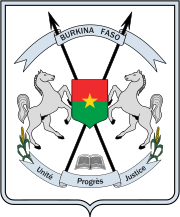Military of Burkina Faso
|
Military of Burkina Faso |
|
|---|---|

Coat of arms of Burkina Faso
|
|
| Service branches | Army Air Force National Gendarmerie National Police People's Militia |
| Leadership | |
| President | Roch Marc Christian Kaboré |
| Minister of Defense and Veteran Affairs | Roch Marc Christian Kaboré |
| Chief of General Staff | Colonel Oumarou Sadou |
| Manpower | |
| Active personnel | 11,200 (IISS estimate 2012: Army 6,400, Air 600, Gendarmerie 4,200) |
| Expenditures | |
| Percent of GDP | 1.2% (2006) |
| Related articles | |
| History |
Agacher Strip War Sierra Leone Civil War Insurgency in the Maghreb |
The branches of Burkina Faso's military include its Army, Air Force, National Gendarmerie, National Police, and People's Militia. Being a landlocked country, Burkina Faso has no navy.
In 1966 a military coup deposed the first president of Upper Volta, Maurice Yaméogo, suspended the constitution, dissolved the National Assembly, and placed Lieutenant Colonel Sangoulé Lamizana at the head of a government of senior army officers. The army remained in power for 4 years; on June 14, 1970, the Voltans ratified a new constitution that established a 4-year transition period toward complete civilian rule. Lamizana remained in power throughout the 1970s as president of military or mixed civil-military governments. After conflict over the 1970 constitution, a new constitution was written and approved in 1977, and Lamizana was reelected by open elections in 1978.
Lamizana's government faced problems with the country's traditionally powerful trade unions and on November 25, 1980, Colonel Saye Zerbo overthrew President Lamizana in a bloodless coup. Colonel Zerbo established the Military Committee of Recovery for National Progress as the supreme governmental authority, thus eradicating the 1977 constitution.
Colonel Zerbo also encountered resistance from trade unions and was overthrown two years later on November 7, 1982, by Major Dr. Jean-Baptiste Ouédraogo and the Council of Popular Salvation (CSP). The CSP continued to ban political parties and organizations, yet promised a transition to civilian rule and a new constitution.
Factional infighting developed between moderates in the CSP and radicals led by Captain Thomas Sankara, who was appointed prime minister in January 1983. The internal political struggle and Sankara's leftist rhetoric led to his arrest and subsequent efforts to bring about his release, directed by Captain Blaise Compaoré. This release effort resulted in yet another military coup d'état on August 4, 1983. Compaoré came to power in a 1987 coup that led to the death of Sankara.
On February 15, 2011, soldiers mutinied in Ouagadougou over unpaid housing allowances. On April 18, 2011, it was reported that the mutiny had spread to Kaya after demonstrations in Pô and Tenkodogo. On April 29, 2011, the army said the mutiny would end after Compaoré promised to improve the military's housing, clothing and food allowances, though there were later protests by soldiers.
...
Wikipedia
